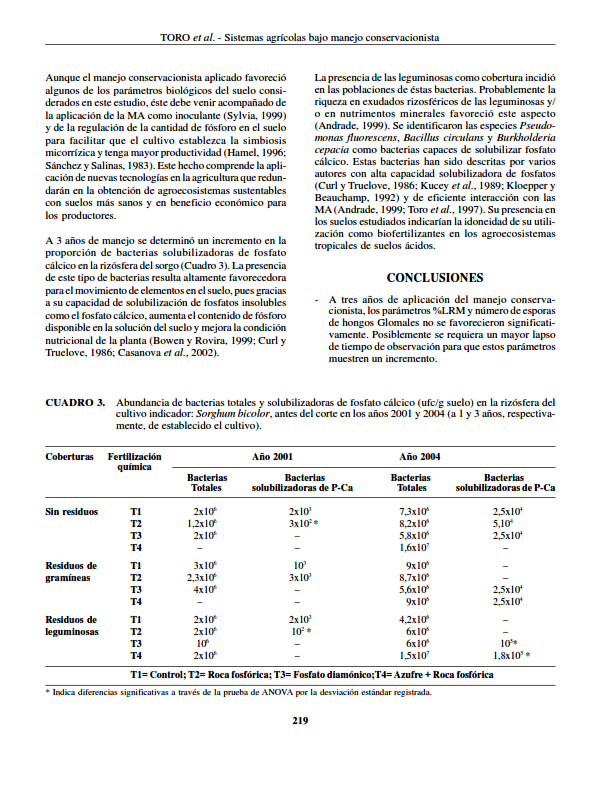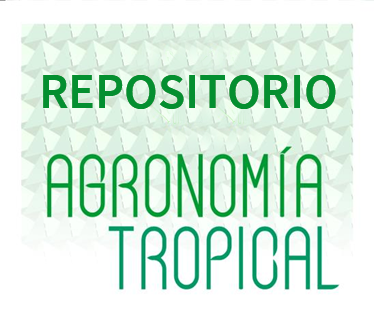Arbuscular mycorrhizae and plant growth promoting rhizobacteria, biofertilizers from sustainable agricultural systems
Abstract
Savanna soils have low natural fertility, acid pH and low levels of N, P and organic matter content. Most of these soils are Oxisols or Ultisols and sustain agricultural systems that have been intensively fertilized affecting biological properties of soils. To improve this condition, conservation practices like green manures and addition of slow release phosphate fertilizers (rock phosphates) have been applied in an agroecosystem located in Espino, Guárico state. To observe the impact of this management practice on the soil we monitored Glomalean arbuscular mycorrhizal (AM) fungi and calcium phosphate solubilizing bacteria in Sorghum bicolor rhizosphere after three years of cultivation under these conditions. Most favorable management will increase phosphate solubilizing bacteria populations and intensity of Sorghum mycorrhizal colonization. Sorghum mycorrhizal colonization was low during the first year (2-8% Root Length Mycorrhization, RLM). Former fertilization and management could influence the low colonization capacity of soil natural inoculums. After three years, Sorghum mycorhizal colonization slightly increased (6-15% RLM) and number of spores decreased (169-315 spores/100 g soil). A slight increase of this parameter was only observed when green manure was absent (169-235 spores/100 g soil), meaning that natural vegetation positively affected AM fungal spores abundance. When legume manure was applied, phosphate solubilizing bacteria populations increased in Sorghum rhizosphere (1,8 x 105 cfu/g soil). Pseudomonas fluorescens, Bacillus circulans y Burkholderia cepacia were identified as acid soils autochthonous phosphate solubilizing bacteria.
Downloads
References
• Barea, J. M. 2001. Interacciones ecológicas de los microorganismos en el suelo y sus implicaciones en agricultura. In: Labrador Moreno, J. y Altieri, M.A. Agroecología y desarrollo. Aproximación a los fundamentos agroecológicos para la gestión sustentable de agroecosistemas mediterráneos. Ediciones Mundi-prensa, Cáceres, 165-184 p.
• Barea, J. M and C. Azcón-Aguilar. 1983. Mycorrhizas and their significance in nodulating nitrogen-fixing plants. Advances in Agronomy. 36:1-54.
• Bethlenfalvay, G. J. and R. G. Linderman. 1992. Mycorrhizae in sustainable agriculture. ASA. Spec. Publ. Madison, Wisconsin.
• Bowen, G. D. and A. D. Rovira. 1999. The rhizosphere and its management to improve plant growth. Advances in Agronomy. 66:1-102.
• Casanova, E., A. M. Salas and M. Toro. 2002. The use of nuclear and related techniques for evaluating the agronomic effectiveness of phosphate fertilizers, in particular rock phosphate, in Venezuela: initial available P and its changes in soils amended with rock phosphate. Nutrient Cycling in Agroecosystems. 63:13-20.
• Curl, E.A. and B. Truelove. 1986. The rhizosphere. Springer-Verlag (Eds). Berlín. 323 p.
• Dodd, J. C. 1999. Recent advances in understanding the role of arbuscular mycorrhizae in plant production. In: Soil fertility, soil biology and plant nutrition interrelationships. Siqueira, J.; Moreira, F.; Lopes, A.; Guilherme, L.; Faquin, V.; Furtini Neto, A. and Carvalho, J. Editors. Sociedade Brasileira de Ciência do solo, Lavras, Brasil. 687-704 p.
• Dodd, J. C., I. Arias, I. Koomen and D. S. Hayman. 1990. The management of populations of vesicular arbuscular mycorrhizae fungi in acid-infertile soils of a savanna ecosystem. Plant and Soil. 122:229-240.
• Giovanetti, M. and B. Mosse. 1980. An evaluation of techniques for measuring vesicular-arbuscular infection in roots. New Phytologist. 84:489-500.
• Hamel, C. 1996. Prospects and problems pertaining to the management of arbuscular mycorrhizae in agriculture. Agric. Ecosyst. Environm. 60:197-210.
• Kloepper, J. W. and C. Beauchamp. 1992. A review of issues related to measuring colonization of plants roots by bacteria. Canadian Journal of Microbiology. 38:1 219-1 232.
• Kucey, R. M. N., H. H. Janzen and Leggett, M.E. 1989. Microbially mediated increases in plant-available phosphorus. Advances in Agronomy. 42:199-228.
• López-Gutiérrez, J. C., M. Toro y D. López-Hernández. 2001. Micorrizas arbusculares y actividades enzimáticas en la rizósfera de Trachypogon plumosus Ness en tres sabanas de suelos ácidos. Acta Biologica Venezuelica. 21:49-57.
• Phillips, J. M. y D. S. Hayman. 1970. Improved procedures for clearing roots and staining parasitic and vesicular-arbuscular mycorrhizal fungi for rapid assessment of infection. Transactions of the British Mycological Society. 55:158-161.
• Sánchez, P. y G. Salinas. 1983. Suelos ácidos y estrategias para su manejo con bajos insumos en América Tropical. SCCS. Bogotá, Colombia. 93 p.
• Sieverding, E. 1991. Vesicular-Arbuscular mycorrhizae management in tropical agrosystems. GTZ, Germany, 371 p.
• Sylvia, D. 1999. Fundamentals and applications of arbuscular mycorrhizae: a biofertilizer perspective. In: Soil fertility, soil biology and plant nutrition interrelationships. Siqueira, J.; Moreira, F.; Lopes, A.; Guilherme, L.; Faquin, V.; Furtini Neto, A. and Carvalho, J. Editors. Sociedade Brasileira de Ciência do solo, Lavras, Brasil. 705-724 p.
• Tarafdar, J. C. and A. Rao. V. 2002. Possible Role of Arbuscular Mycorrhizal Fungi in Development of Soil Structure. In: Arbuscular Mycorrhizae. Interactions in Plants, Rhizosphere and Soils. Sharma, A.K. and Johri, B.N. Eds. Science Publishers, Inc. Enfield, USA. 186-206 p.
• Toro, M., Azcón, R. and J. M. Barea. 1997. Improvement of Arbuscular Mycorrhizal development by inoculation with Phosphate Solubilizing Rhizobacteria to benefit rock phosphate bioavailability (32P) and nutrient cycling. Applied and Environmental Microbiology. 63(11):4 408-4 412.
• Toro, M., Blones, J. y I. Hernández-Valencia. 2001. Dinámica del fósforo y actividad biológica en las micorrizósferas de dos ecosistemas adyacentes con vegetación y suelos contrastantes. Acta Biol. Venez. 21(2):21-28.
• Toro, M. y D. López-Hernández. 1998. Potencialidades del manejo de las Micorrizas Arbusculares para el desarrollo sostenido de los sistemas agrícolas de bajos insumos del ecotono sabana-bosque amazónico. In: Carrillo, R J. (Compilador). Memorias del IV Congreso Interamericano sobre el medio ambiente realizado en Caracas, Venezuela, entre el 8 y 11 de diciembre de 1997. Colección Simposia. p. 222-227.





